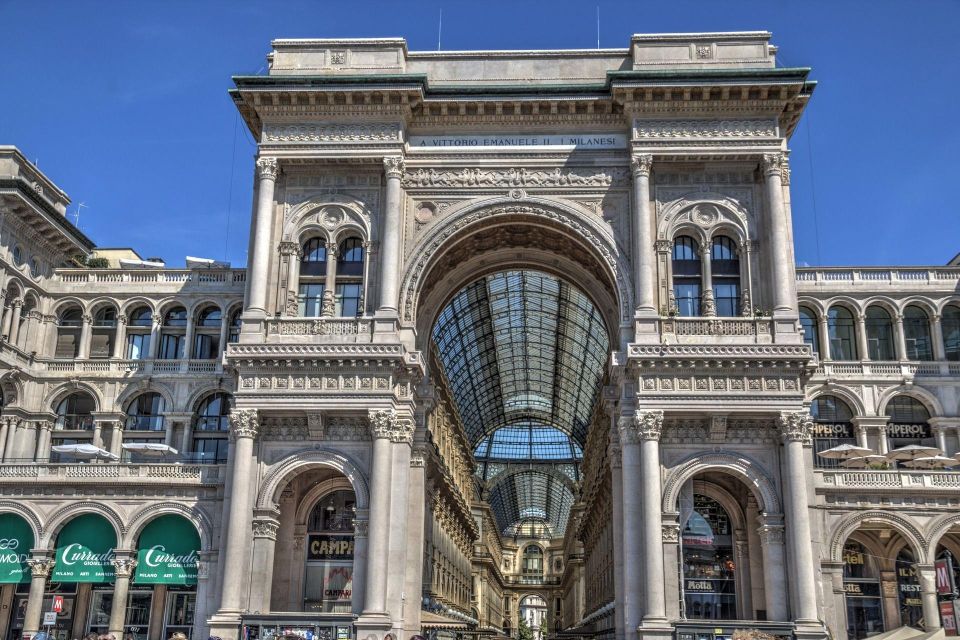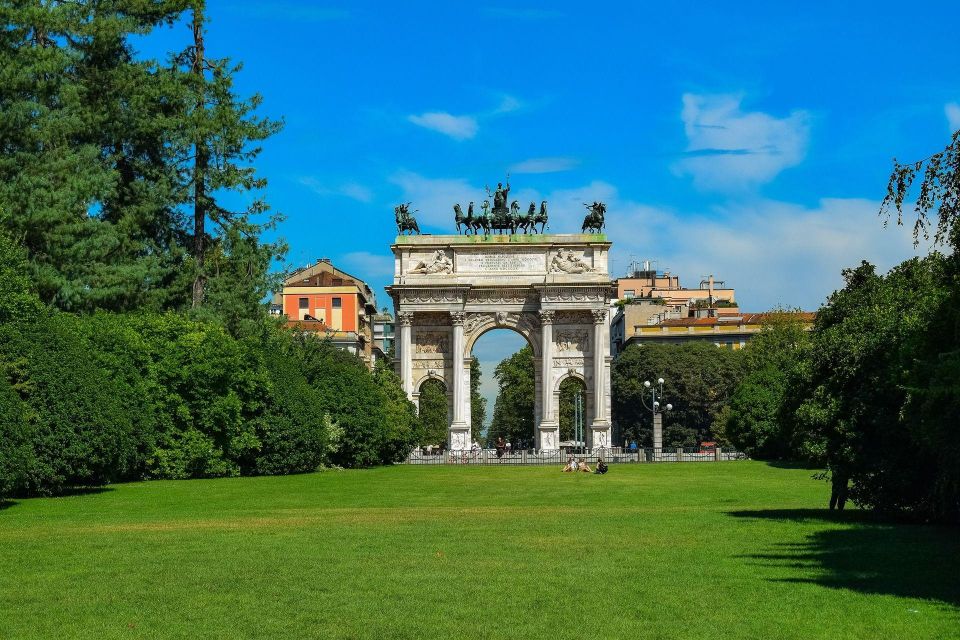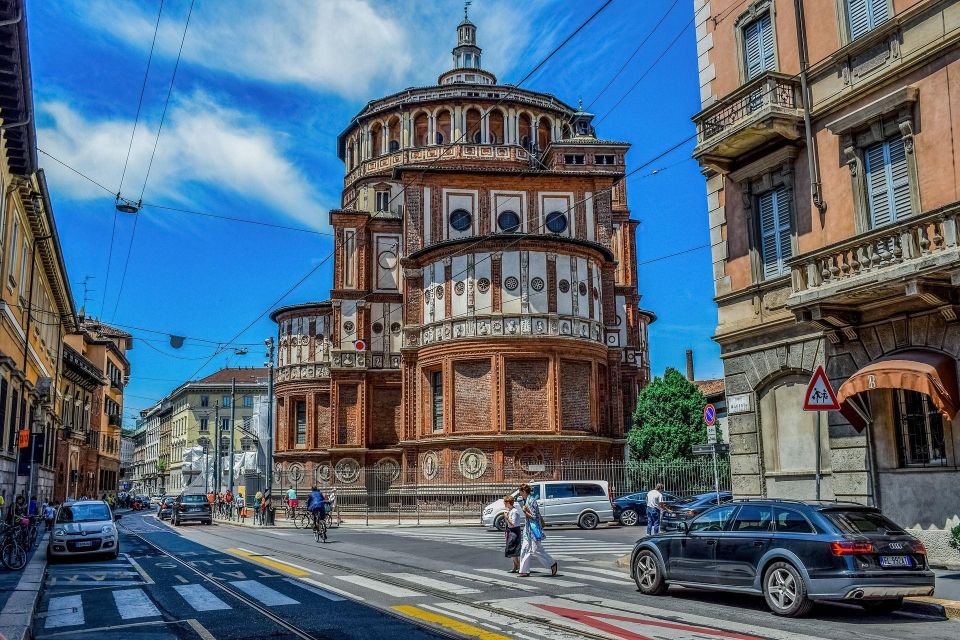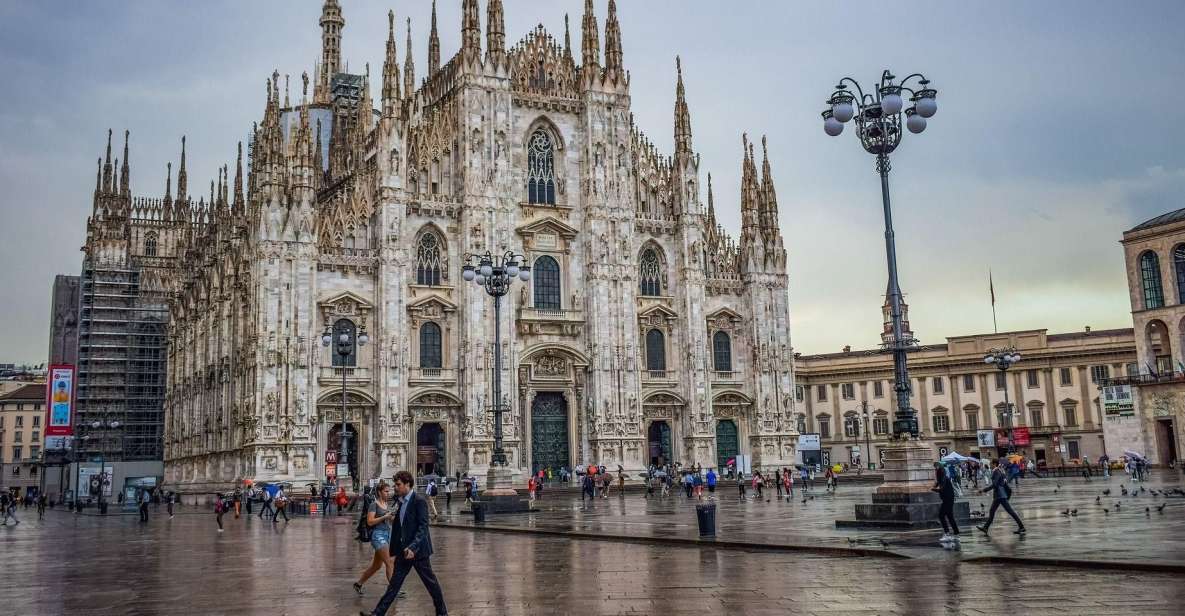Uncover the captivating history of Milan through an immersive private walking tour. From its ancient Celtic roots to its significant role as the former capital of the Kingdom of Italy, the city’s storied past comes alive as you explore its grand buildings and bustling streets. Marvel at the architectural remnants that dot the landscape, reflecting the influences of the Visigoths, Ostrogoths, and the landmark Peace of Constance agreement. This guided experience promises to transport you back in time, unveiling the rich tapestry that defines Milan’s enduring legacy. Prepare to be enthralled as you delve deeper into the city’s fascinating heritage.
Key Points

- Explore Milan’s rich Celtic heritage by visiting archaeological sites and museums that showcase artifacts and insights into the Insubres, the powerful Celtic tribe that settled the region.
- Discover the lasting impact of the Visigothic siege of 402 CE and the Ostrogothic conquest of 539 CE, which shaped Milan’s history and development.
- Learn about the Peace of Constance in 1183, a landmark agreement that granted Milan significant autonomy and secured its position as a leading commercial and cultural center.
- Understand Milan’s role as the capital of the Kingdom of Italy in the 19th century, marked by infrastructure development and its emergence as the financial and industrial heartbeat of the nation.
- Gain a comprehensive understanding of Milan’s multifaceted history and how it has evolved into a vibrant, modern city while preserving its distinct cultural and architectural legacies.
Celtic Insubres Roots

Although Milan’s history dates back to the Celtic Insubres, who established a settlement in the region around the 6th century BCE, the city’s Celtic roots played a significant role in shaping its early development.
The Insubres were a powerful Celtic tribe that controlled a large swath of northern Italy, including the area where modern-day Milan is located. They left a lasting imprint on the city’s architecture, infrastructure, and cultural traditions.
Remnants of their settlements can still be seen in Milan’s urban landscape, serving as a testament to the enduring influence of the Insubres. Today, visitors can explore the city’s Celtic heritage by visiting archaeological sites and museums that showcase the artifacts and insights into this formative period of Milan’s past.
You can also read our reviews of more walking tours in Milan
Visigothic Siege of 402

In 402 CE, the Visigoths, a powerful Germanic tribe, launched a siege against the city of Milan, then the capital of the Western Roman Empire.
Led by their king, Alaric I, the Visigoths sought to seize control of the city and weaken the crumbling Roman Empire.
The siege was a brutal affair, with the Visigoths employing a range of siege weapons and tactics to breach the city’s defenses.
Ultimately, the Romans were able to hold off the Visigothic assault, thanks in part to the city’s strong fortifications and the bravery of its defenders.
However, the siege marked a significant turning point in the decline of Roman power in the region.
Ostrogothic Conquest in 539

After the Visigoths had been repelled from Milan, the city soon faced another threat – the Ostrogoths.
In 539 CE, the Ostrogothic king Totila led his armies to conquer the city, determined to expand his kingdom’s influence in northern Italy. The siege was intense, with the Ostrogoths employing advanced siege tactics to breach the city’s defenses.
Milan’s residents fought bravely, but ultimately the Ostrogoths emerged victorious, taking control of the city. This conquest marked a significant shift in the balance of power in the region, as the Ostrogoths solidified their grip on northern Italy.
The impact of the Ostrogothic conquest would be felt for years to come, shaping Milan’s history and development.
Peace of Constance in 1183
The Peace of Constance in 1183 marked a pivotal moment in Milan’s history, as the city negotiated a landmark agreement with the Holy Roman Empire. This treaty ended decades of conflict and granted Milan significant autonomy, allowing the city to maintain its institutions and laws. It also secured Milan’s position as a leading commercial and cultural center within the empire. The key terms of the Peace of Constance are outlined in the following table:
| Provision | Description |
|---|---|
| Self-Governance | Milan retained the right to elect its own consuls and govern itself. |
| Tax Exemptions | The city was exempted from certain imperial taxes and dues. |
| Trade Privileges | Milan gained favorable trade concessions within the empire. |
| Religious Freedoms | The Milanese were granted religious liberties and freedoms. |
This hard-won agreement ushered in a period of stability and prosperity for Milan, cementing its status as a vital economic and political force in medieval Italy.
More Great Tours NearbyMilan as Kingdom of Italy Capital
Milan served as the capital of the Kingdom of Italy for several decades in the 19th century. Elevated to this prestigious status in 1861 following the unification of Italy, the city played a pivotal role in consolidating the new nation’s political and economic power.
As the capital, Milan:
- Became the seat of the Italian government, hosting the royal palace, parliament, and other key institutions.
Milan also experienced a surge in infrastructure development, including the construction of railways, roads, and public buildings to accommodate the influx of bureaucrats and officials.
On top of that, Milan solidified its position as the financial and industrial heartbeat of the kingdom, attracting businesses and investments that fueled Italy’s economic growth.
You can also read our reviews of more private tours in Milan
- Sauze Doulx : Private Transfer To/From Malpensa Airport
- From Milan: Piemonte Private Wine Tour With a Private Driver
- Private Transfer To/From Siena and Center of Milan
- Portofino : Private Transfer To/From Malpensa Airport (Mxp)
- Bardonecchia : Private Transfer To/From Malpensa Airport
- Bern : Private Transfer To/From Malpensa Airport
Tour Duration and Languages
This private walking tour of Milan lasts a duration of 2 hours, providing ample time for visitors to explore the city’s highlights.
Tour guides offer their services in both English and Italian, catering to the diverse language preferences of participants.
Whether you’re a native Italian speaker or an English-only visitor, you’ll be able to fully engage with the tour and gain a deeper understanding of Milan’s rich history and culture.
The tour’s flexibility in language options ensures that everyone can enjoy the experience and make the most of their time in this vibrant city.
With a local professional guide leading the way, you’ll embark on an informative and immersive exploration of Milan.
Meeting Point and Booking Details

The tour meeting point is at the iconic Duomo di Milano, located in Piazza del Duomo, 20122 Milano MI, Italy.
Booking this private walking tour of Milan is easy – you can reserve your spot now and pay later, ensuring a hassle-free experience.
The tour’s highlights include:
- Exploring Milan’s Celtic Insubres roots
- Uncovering the Ostrogothic conquest in 539
- Experiencing Milan as the capital of the Kingdom of Italy
The tour is priced from $270.31 per group up to 15 people, and you can cancel for free up to 24 hours in advance.
With a local professional guide and the option to customize the tour, this is an excellent opportunity to discover Milan’s rich history.
Tour Inclusions and Cancellation Policy
This private walking tour includes a local professional guide who can potentially customize the experience. Plus, customers enjoy the convenience of free cancellation up to 24 hours in advance.
The guide’s expertise allows participants to explore Milan’s rich history, exploring its Celtic Insubres roots, the Visigothic siege in 402, and the Ostrogothic conquest in 539. Guests will also learn about the pivotal Peace of Constance in 1183 and experience Milan’s time as the capital of the Kingdom of Italy.
This well-rounded tour provides an insightful and flexible experience, giving travelers the freedom to adjust their plans if needed without penalty.
Frequently Asked Questions

What Is the Dress Code for the Tour?
There is no specific dress code for the tour. Participants should wear comfortable walking shoes and dress appropriately for the weather conditions. The tour provider does not provide any dress requirements.
Can We Stop for a Meal During the Tour?
Yes, participants can typically stop for a meal during the tour. Many tour operators encourage breaks to allow guests to rest, refuel, and experience local cuisine. However, the specific details would need to be confirmed with the tour provider.
Is the Tour Wheelchair Accessible?
The tour is wheelchair accessible. The guide can accommodate guests with mobility challenges and adjust the pace and route as needed to ensure a comfortable and enjoyable experience for all participants.
Can We Take Photographs During the Tour?
Yes, participants are generally allowed to take photographs during the tour. The guide will provide guidance on appropriate photo opportunities throughout the experience. Guests should be mindful not to disrupt the tour or other participants.
Is There a Discount for Students or Seniors?
Yes, the tour company offers discounts for students and seniors. They typically provide a 10% discount with valid identification. To take advantage of the discount, simply mention it when booking the tour.
Recap
Milan’s private walking tour offers a captivating journey through the city’s rich history.
From the ancient Celtic Insubres to the Visigothic and Ostrogothic sieges, visitors can explore the landmark Peace of Constance and the city’s role as the capital of the Kingdom of Italy.
The tour immerses guests in Milan’s storied past, bringing its captivating legacy to life in a personalized, informative experience.
You can check availability for your dates here:More Walking Tours in Milan
More Tours in Milan
- Verona, Romeo & Juliet, private guided tour from Milan
- Ferrari Museum, Private Tour from Milan
- La Scala Opera House, Musical Tour – Private tour – Skip-the-Line
- Milan 6hr Private Walking Tour with Certified Guide
- Milan Private Tour: Highlights & Hidden Gems with a Local
- Private Wine Tour: Terraced Vineyards with Alpine view from Milan
More Tour Reviews in Milan
Not for you? Here's more nearby things to do in Milan we have reviewed
- Verona, Romeo & Juliet, private guided tour from Milan
- Discover the food valley and cook with truffle
- Private photo shoot in Milan Duomo and Photo Studio
- Private Transfer Milan Bergamo Airport BGY to Milan City
- Ferrari Museum, Private Tour from Milan
- Lake Como cruise, St.Moritz and Bernina Red Train
- La Scala Opera House, Musical Tour – Private tour – Skip-the-Line
- Malpensa Airport Milan(MXP) to Como – Roundtrip Private Transfer
- 3 Hours of Wonders in Milan (3km Friendly & Easy Walk)
- Milan 6hr Private Walking Tour with Certified Guide
- Milan Private Tour: Highlights & Hidden Gems with a Local
- Milan Airport to Zermatt Private Transfer
